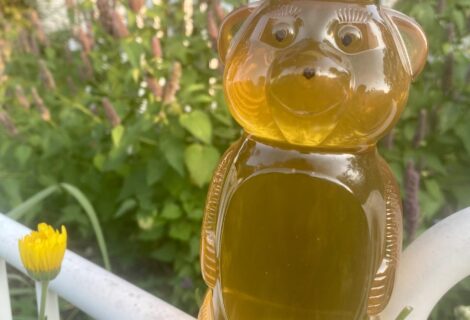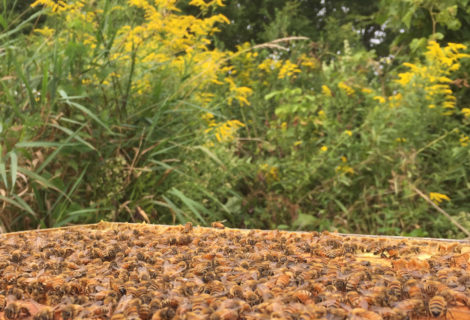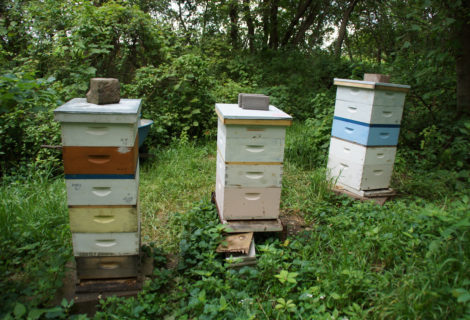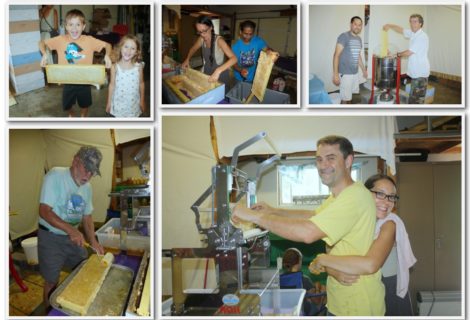Are the bees alive?
As we turn the corner from November into December, all 15 colonies between OBA and my folk’s hives are alive. That’s good news! At this point last year, at least a couple colonies had already “crashed” from weakness/illness caused by too high a mite load. I didn’t keep good records on when each colony had no more signs of life through the winter, but this year I intend to do better. During the days that have reached the upper 40s and beyond, we have seen the bees flying or crawling around at all the hive entrances. Because of earlier hard frosts, there is no more nectar or pollen, so what are they doing? They are pushing out dead bees and generally cleaning the bottom of the hive where the dead bees fall and start to pile up. They are also cleansing their guts in preparation for the long winter months ahead. Bees don’t defecate in the hive (unless they get sick with dysentery), so their bowls get pretty full and they need to ‘purge’ on any days that are warm enough to fly.
In this picture, the bees are checking out a newly installed mouse-guard over the Thanksgiving holiday. Their entrance is pretty small (just over an inch wide), but a thin and hungry mouse could manage to squeeze through, and the metal mesh (hardware cloth) helps prevent that.
It’s hard to believe that just over a month ago, the bees were still visiting flowers in our backyard…
How warm does it need to be for bees to fly?
For general nectar or water gathering, I think the consensus is around 47 deg F. That is on a cloudy day. At that temperature, the bees can land outside the hive and are just able to maintain or generate the 86 deg F thoracic temperature required for flight. In other words, the honey bee (a cold blooded creature) must get its thorax muscles to 86 F before they can lift off. So how do they do it when it’s cool? They are able to “unhinge” their wings from their flight muscles. They can then run their flight muscles at “full throttle”, so to speak, without air resistance because their wings aren’t flapping. This generates heat, after which they can re-hinge or dock their wings in and take off at the 220 beats per second required. Incidentally, this is the same mechanism bees use to regulate temperature in the hive. It’s kind of like shivering.
If it’s a sunny day, they could be out at temps lower than 47 F because they can absorb more heat from the sun. If the bees don’t need to gather anything (perhaps they are just out to stretch their wings, or relieve themselves), then they can fly at lower temperatures (even below freezing) for a short time — because they can engage their wings next to the warmth of the winter cluster within the hive, fly out of the hive, circle around, and fly right back in. If they’re lucky. If not, they will hit the snow or even the landing board entrance to the hive and slowly die because the air temperature is too low for them to even crawl very far. The other case is if the bee is sick and knows it. She will fly out of the hive, even at temps well below survival threshold, with no intention of returning. This is called altruistic sacrificial behavior and honey bees practice it a lot. It reduces the spread of a contagion from one bee to the next that would otherwise happen in a close-knit cluster.
How do we “medicate” bees in the fall?
Today’s honeybees generally need to be treated for parasitic varroa mites, otherwise the mite infestation increases to levels that the colony cannot tolerate and debilitating viruses are spread from the mites throughout the colony. Treatment is not considered a long-term solution and perhaps I will have a future article on honey bee genetics and breeding for mite tolerance and/or resistance.
In the fall, the queen slows egg production to a great extent and we are able to treat with oxalic acid, which the mites do not tolerate well. It is not easy on the bees either, but it kills a lot of the mites outright that are physically attached to the bees. Here is a photo of a mite on the thorax of one of our bees.
This fall I was able to borrow an oxalic acid vaporizer from a friend down the street. In past years, I would just dribble an acid solution of sugar water on the bees, but the vaporizer seems to be a simpler and perhaps more effective treatment delivery vehicle. In the following photo, you can kind of see the device laying on a white board next to the hive. A small amount of the oxalic crystals are placed in the metal pan. It is then slid through the entrance to the hive under the brood boxes. It has wires that are connected to the two terminals of a battery. This heats the pan and vaporizes the crystals.
The vapor condenses onto the exoskeleton of the bees where it is lethal to the mites. A towel, or in our case, and old shirt is used to block the rest of the entrance to the hive for several minutes to keep the fumes from escaping. We wear breathing masks with filters to protect ourselves from the vapor. The following hive is in the middle of a treatment.
A week later I went back to the hives. I found a lot of dead mites under the entrance reducers and near the entrances, like in the photo to the left. Unfortunately, the mites that are reproducing in the capped brood cells of the bees are not affected, so you need to do multiple treatments in a row (separated by maybe a week) to be more effective. I was not able to get down to Iowa with the vaporizer that frequently and I was a bit hesitant at exposing the colonies to the increased caustic side-effects of multiple treatments. We will see how the colonies fare this winter and that will likely inform treatment choices next fall.
The previous two falls were relatively warm compared to this year and so likely had higher brood production in Oct/Nov. That would have reduced the effectiveness of the treatments and autopsies of the “dead-outs” showed significant brood nests going into at least December. I’m hoping the cooler October and early November weather this fall will work out in our favor, with respect to colony health and “mite load” going into the winter.












Recent Comments